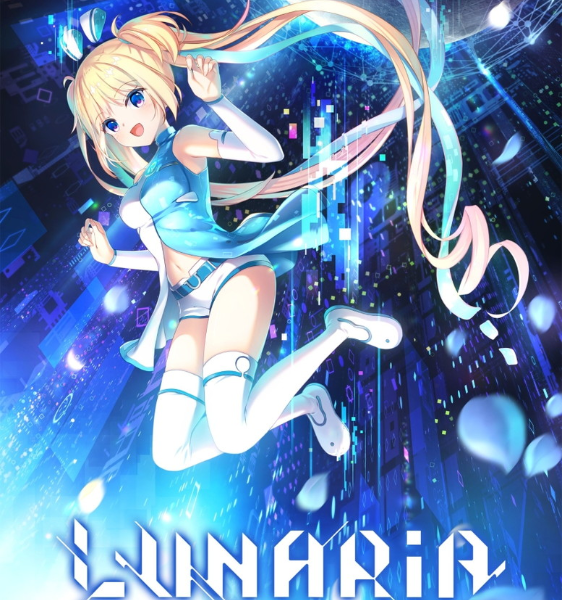I hadn’t initially planned on buying this, but it showed up on the Nintendo eShop one day, and seeing as I liked another kinetic novel made by Key/Visual Arts, Harmonia, and had some eShop money left over from Christmas, I figured I’d give Lunaria: Virtualized Moonchild a shot, as I do want to support the visual novel industry. Granted, Lunaria is another kinetic novel like Key’s previous ones Harmonia and Planetarian, so you don’t get any choices to change the story and get just one ending. And initially, the first half of Lunaria was kinda…cliche and boring. But I stuck it out, and that wound up being a good decision on my part since the second half drastically improves and makes up for the problems the first half of the game had.
In a not-too-far off future, Japan has built most of its infrastructure around COZMO, a deep dive VR cyberspace similar to the internet where people do whatever they want, such as play games, experience augmented reality, the works. It’s basically to this game what OZ is to Summer Wars, if you want a simple explanation. One of the more popular games in COZMO is Skyout Forever (SOF for short), a VR racing game whose competitions can net you a lot of prize money. High schooler Tabito Kamishiro partakes in these races under the username T-Bit and has made quite a name for himself. However, during one race in particular, he finds himself mysteriously transported to an unknown server called Lunar World, and there, he meets a…very energetic and cheerful AI girl calling herself Lunar-Q, who happens to be one of his biggest fans. She claims to have been created to be a mascot for the Selene Corporation, the parent company of COZMO, to promote a lunar development project, but was rejected. At first, T-bit is put off by her saccharine bubbliness and lack of boundaries, but she offers to help him win more of his races. Being a lone wolf by nature, T-Bit doesn’t take to the idea at first, but does accept her help later on. The two become friends, a decision that causes their fates to intertwine.
Lunaria: Virtualized Moonchild contains quite a few of Key’s hallmarks for all of their projects: Snarky male lead character, cutesy girls adhering to an archetype such as the bubbly one and the tsundere, the blonde friend who’s the designated comic relief, comedic hijinks in the first half before swerving hard into the drama in the second half, romance between the two leads which gets tested through hardship and circumstances, you know the drill. Lunaria leans much more into hard sci-fi than their usual output, more so than even Planetarian and Harmonia if you can believe it. I don’t think other Key games I know of go into stuff like seedy corporations trying to sweep tragedy under the rug, eSports, and exploring just how painful isolation and loneliness can be on a psychological level. For anyone worried that Jun Maeda wrote the scenario for this game, don’t worry, he’s not involved with this one. I did some research, and the reason Lunaria leans harder into sci-fi is because Key hired an actual novelist who wrote sci-fi novels, Takeshi Matsuyama, to write the scenario for this one. I even heard that this is actually Matsuyama’s first time working on a video game in general, and after getting hired to work on this, he played some of Key’s other games to get a feel for how video games are written compared to novels. Gotta respect the guy’s dedication to his work.
As somebody who normally doesn’t tend to like hard sci-fi stories because they tend to rely too much on nonsensical technobabble, the sci-fi aspect of Lunaria: Virtualized Moonchild actually managed to be somewhat comprehensible to me. It doesn’t try to be bigger than it is and keeps whatever fantastical elements relevant to the characters and the story its trying to tell. Granted, some parts really do stretch one’s suspension of disbelief, though without giving away spoilers, it’s nowhere near as much as Harmonia’s sci-fi elements did. Speaking of the story, Matsuyama really seems to like foreshadowing and making use of the Chekhov’s gun. Everything important to Lunaria and its narrative has been laid-out from start to finish using in-universe logic that actually makes sense, and every story beat never feels like it came out of nowhere or pulled out of its ass for convenience’s sake. Everything in Lunaria gets followed up on or given a solid explanation, making it feel really tight storywise, which makes the drama and the second half’s big twist hit harder and actually feel earned in that it completely recontextualizes everything in the first half of the game.
Note that a lot of this applies to the second half of the game, as I mentioned previously. Whether you’ll like Lunaria: Virtualized Moonchild as a whole will depend on if you’ll like the first half of the game, which consists of a lot of Key’s trademark cliches, especially comedic hijinks and cutesy anime girls who screech and shriek like it’s nobody’s business. Yeah, at the start, the characters are pretty archetypal and uninteresting, with Lunar-Q and Myau in particular being the most contentious. If you like cutesy anime girls who are either over-the-top bubbly or over-the-top tsunderes who freak out at everything, you might be able to tolerate them just fine, but I did find them really, really annoying in the first half, especially with how squeaky and overly high pitched their voices are. Seriously, MYAU’S VOICE IS ANNOYING AS FUCK!! It’s bad enough that she’s a one-note tsundere cat girl whose only personality traits are that she crushes on T-Bit and jumps to wild conclusions over the absolute dumbest things, but it seems like her seiyuu was told to make her sound as utterly screechy, shrieky, and obnoxious as humanly possible.
If there’s one thing I appreciate about Key games, it’s that they give you the option of muting characters’ voices individually, and I’m not gonna lie, I was so tempted to put Myau’s voice on mute every time she opened her mouth. Just listening to her shriek “Meow!” every other sentence made me want to stab my eardrums with ice picks. The boys don’t have this problem, thankfully, and I did enjoy T-Bit and Gaya as characters, even if T-Bit’s whole character arc is just your typical “lone wolf becomes more social thanks to befriending cute peppy girl” plotline. As predictable as his character arc is, T-Bit at least develops, grows past his flaws, and isn’t an unrepentant jackass like Kouhei Orihara from ONE, I’ll give him that. Though in fairness, Lunar-Q’s over-the-top peppiness does get explained in the second half of the game and we do learn there’s more to her than just being cutesy moe, though I can understand people being put off by her in the beginning.
Both the graphics and the music do their job pretty well, even if the girls’ designs do lean a little too much into your typical moe style. And in case anyone is worried, there’s no fanservice or anything sexual in here. With Lunaria being a kinetic novel, it’s fairly short, running at a little under 10 hours, though since I muted some characters’ voices, my playthrough was only 5 hours, so you can play it without feeling like you’re putting too much time into it. Overall, Lunaria: Virtualized Moonchild is a game that’s actually better on a second or third playthrough because of how the late-game twists completely recontextualize everything in the first half, even if it still has a lot of Key’s quirks. While it is held back by a lot of the early game’s clicheness and Myau being an annoying tsundere with no depth to her whatsoever, I actually did find myself liking Lunaria: Virtualized Moonchild more than I did once I finished playing it, and I say this as somebody who normally isn’t into harder sci-fi stories. Still waiting on a Switch release of Stella of the End, Key!
The post Guest Post: Unearthed Baubles with Firechick – Lunaria: Virtualized Moonchild (77/100) appeared first on Star Crossed Anime.




